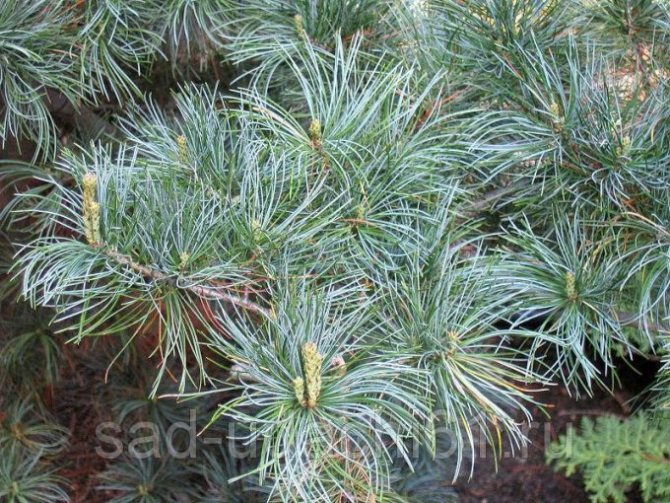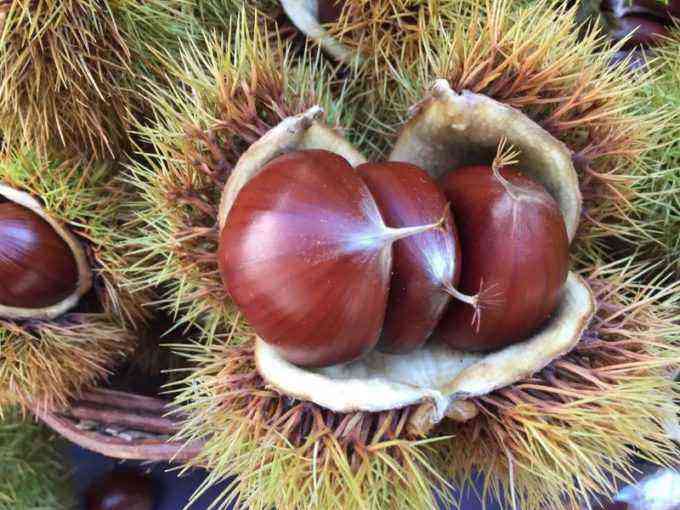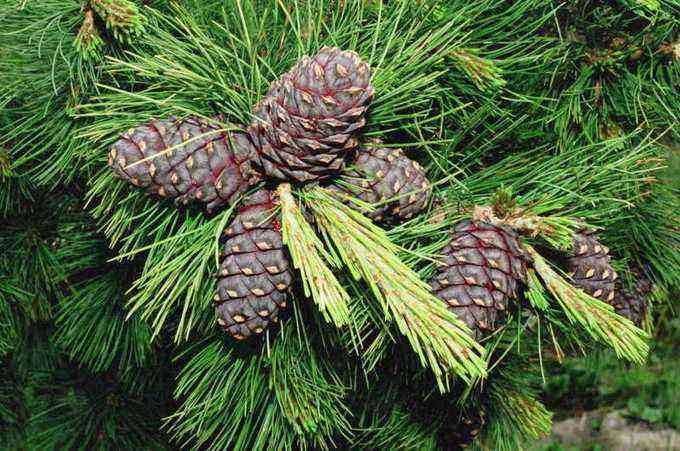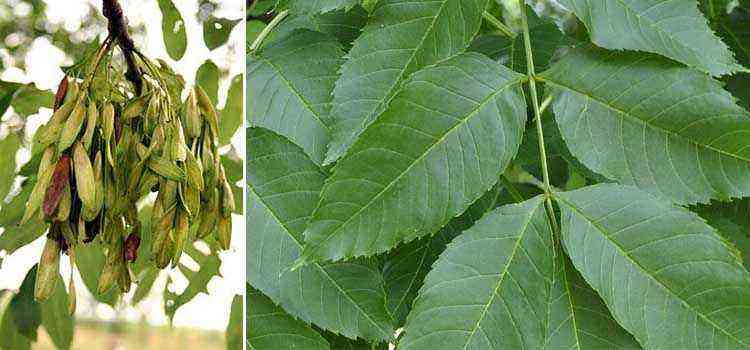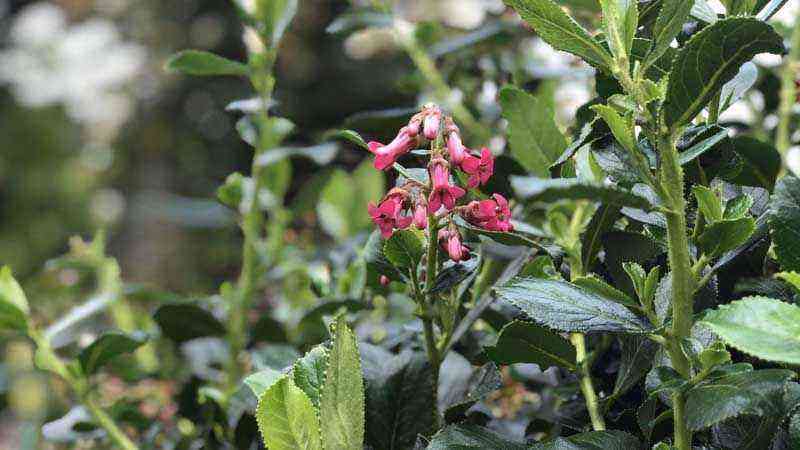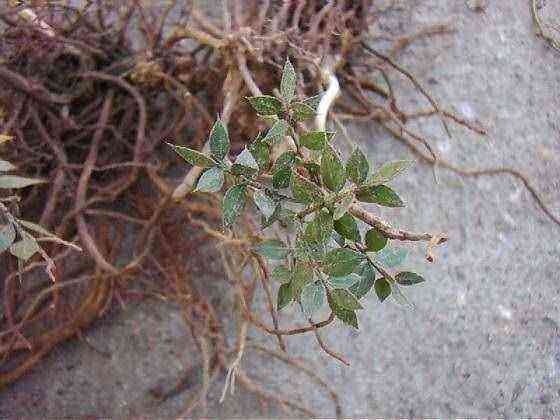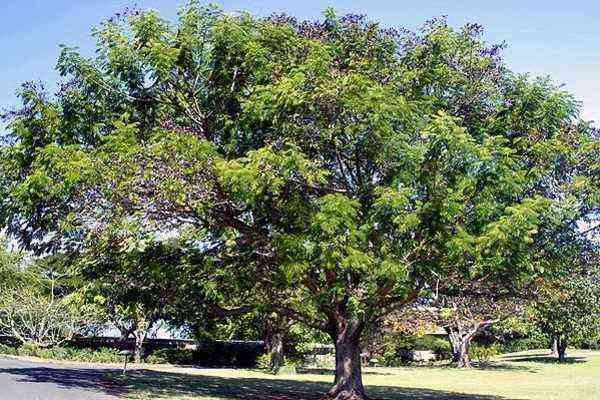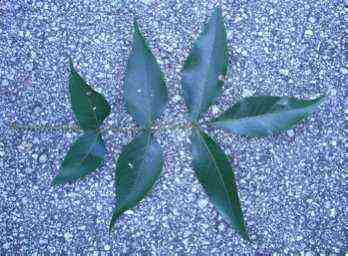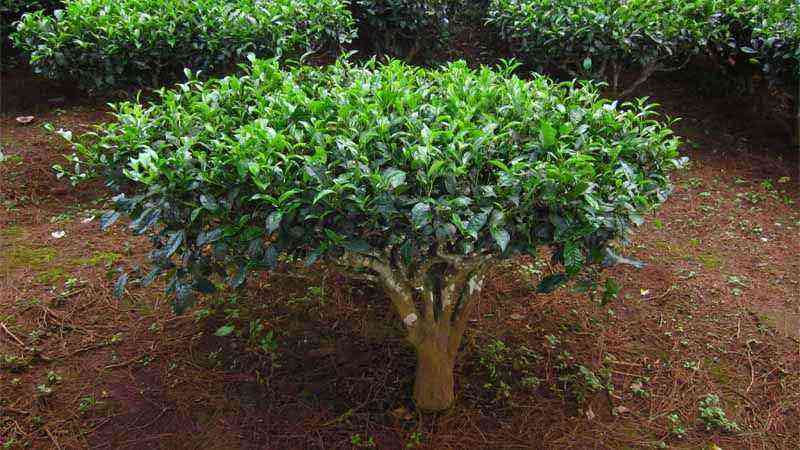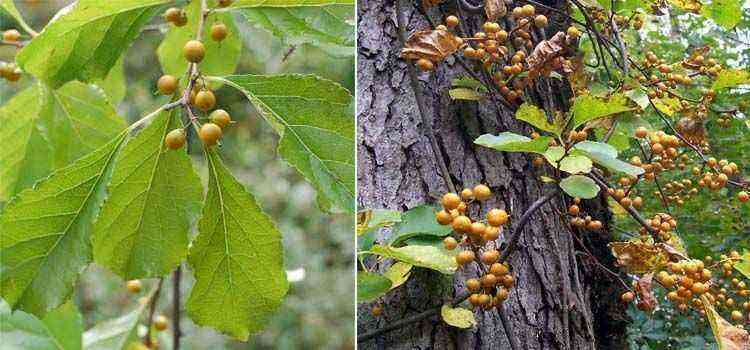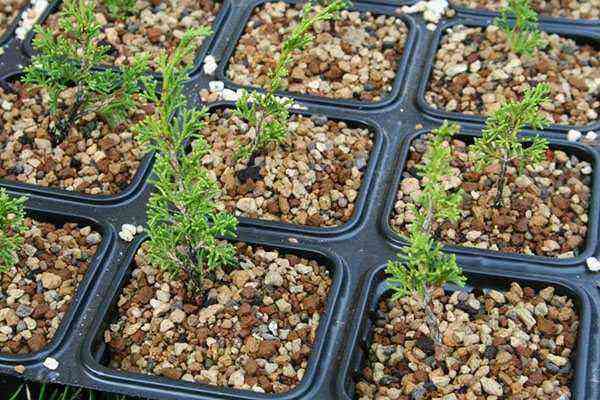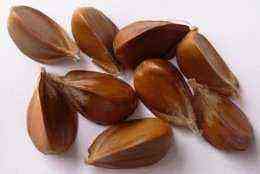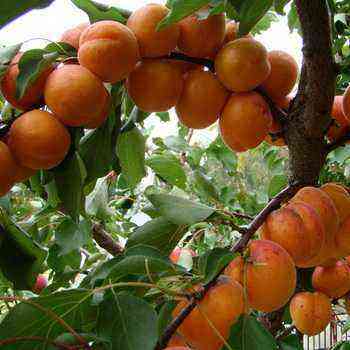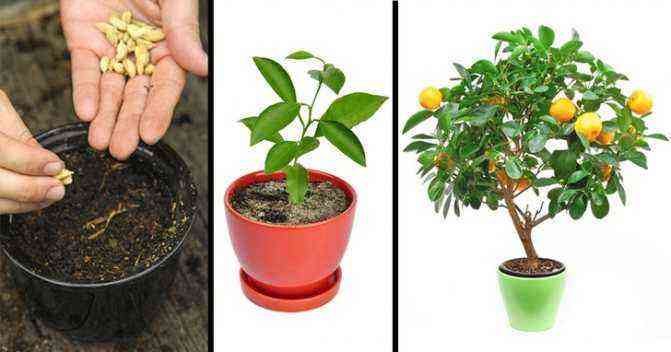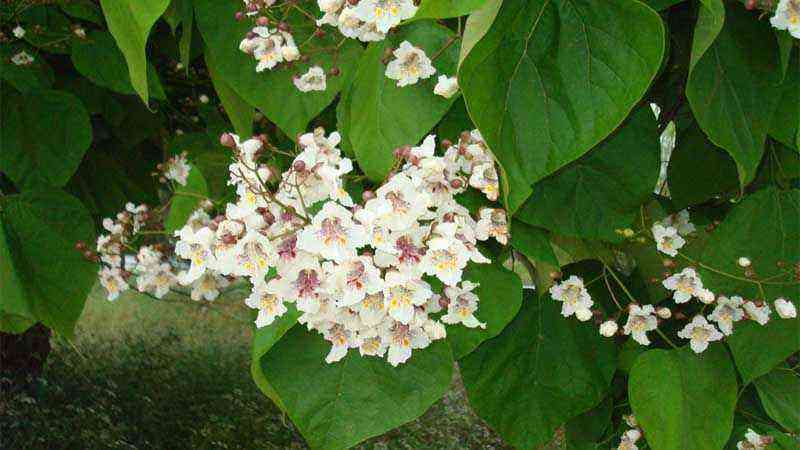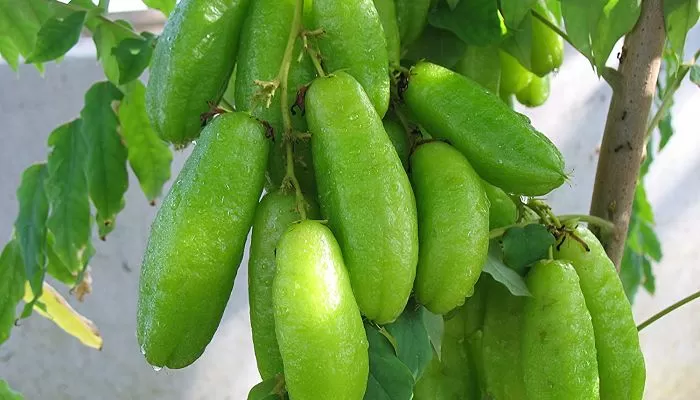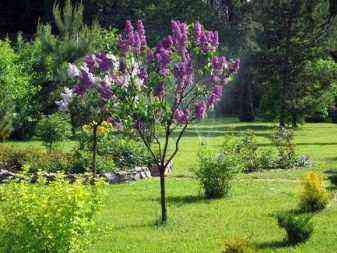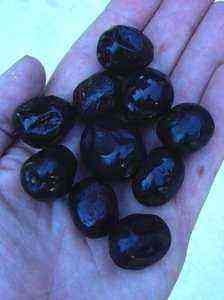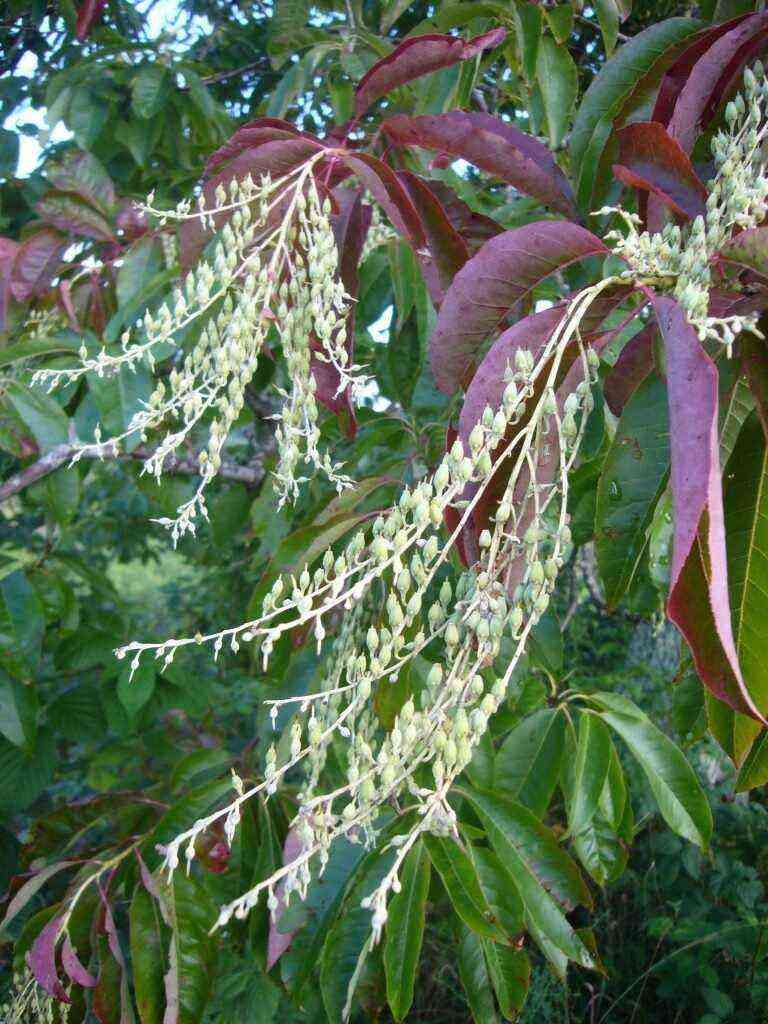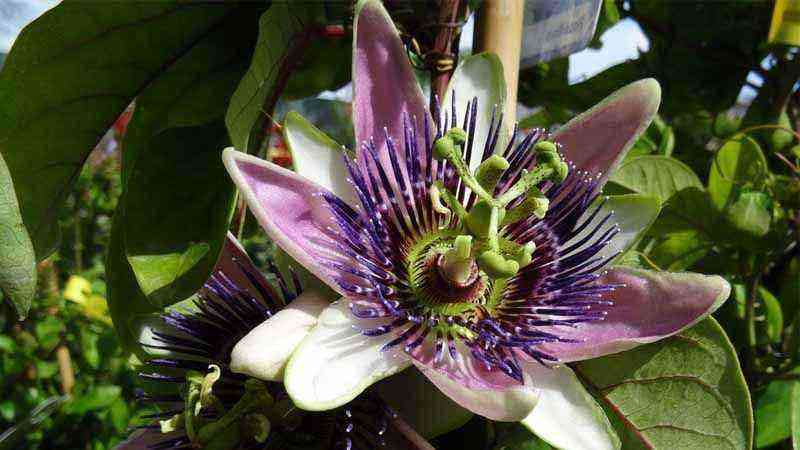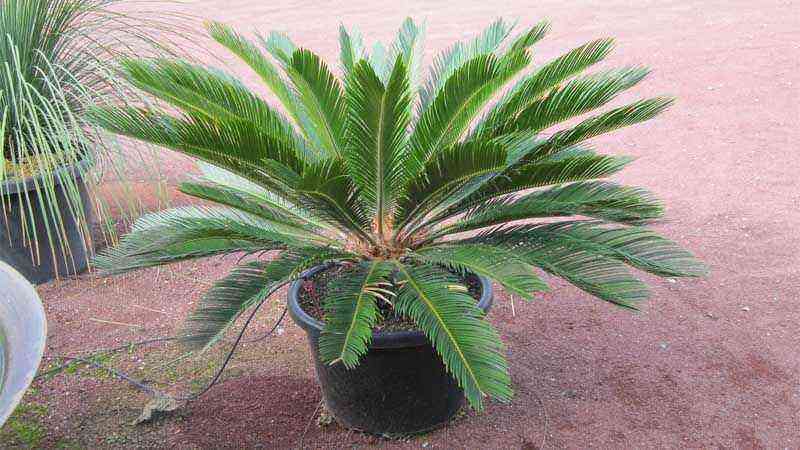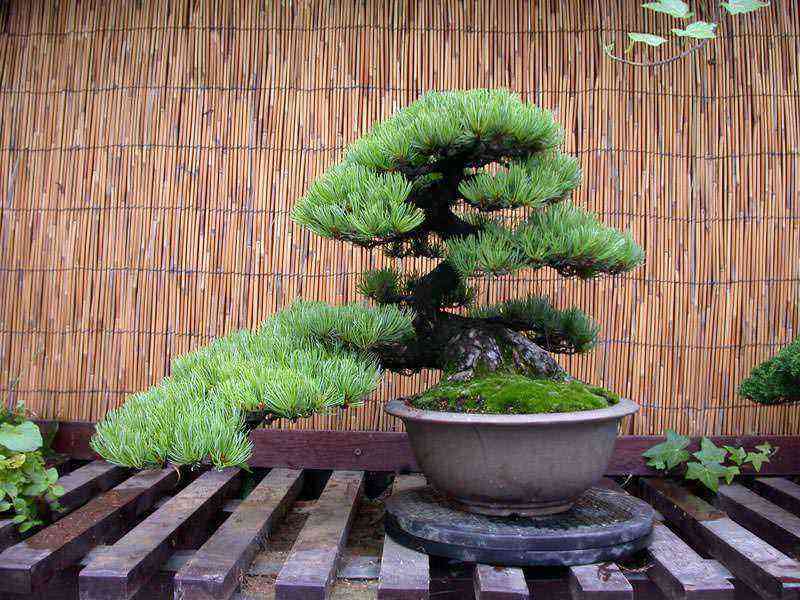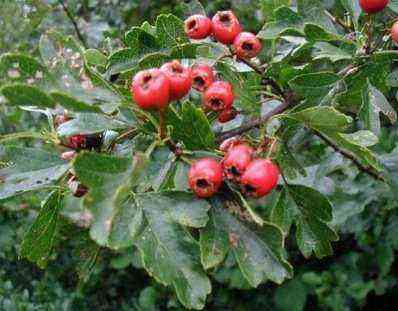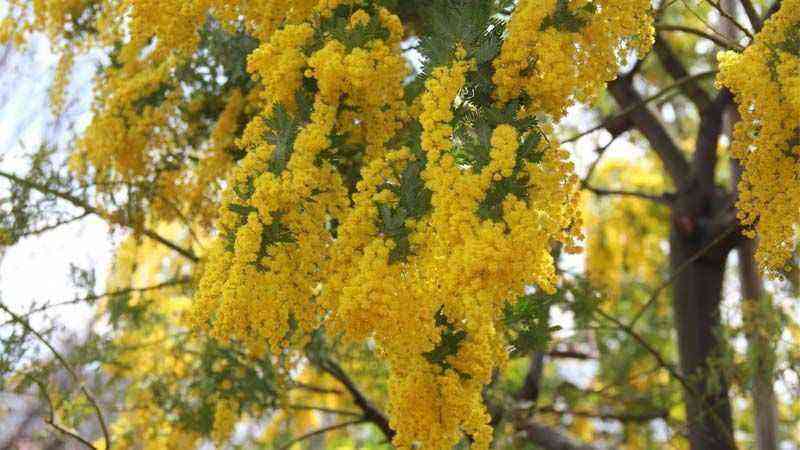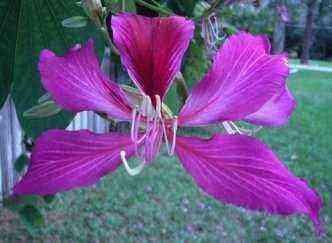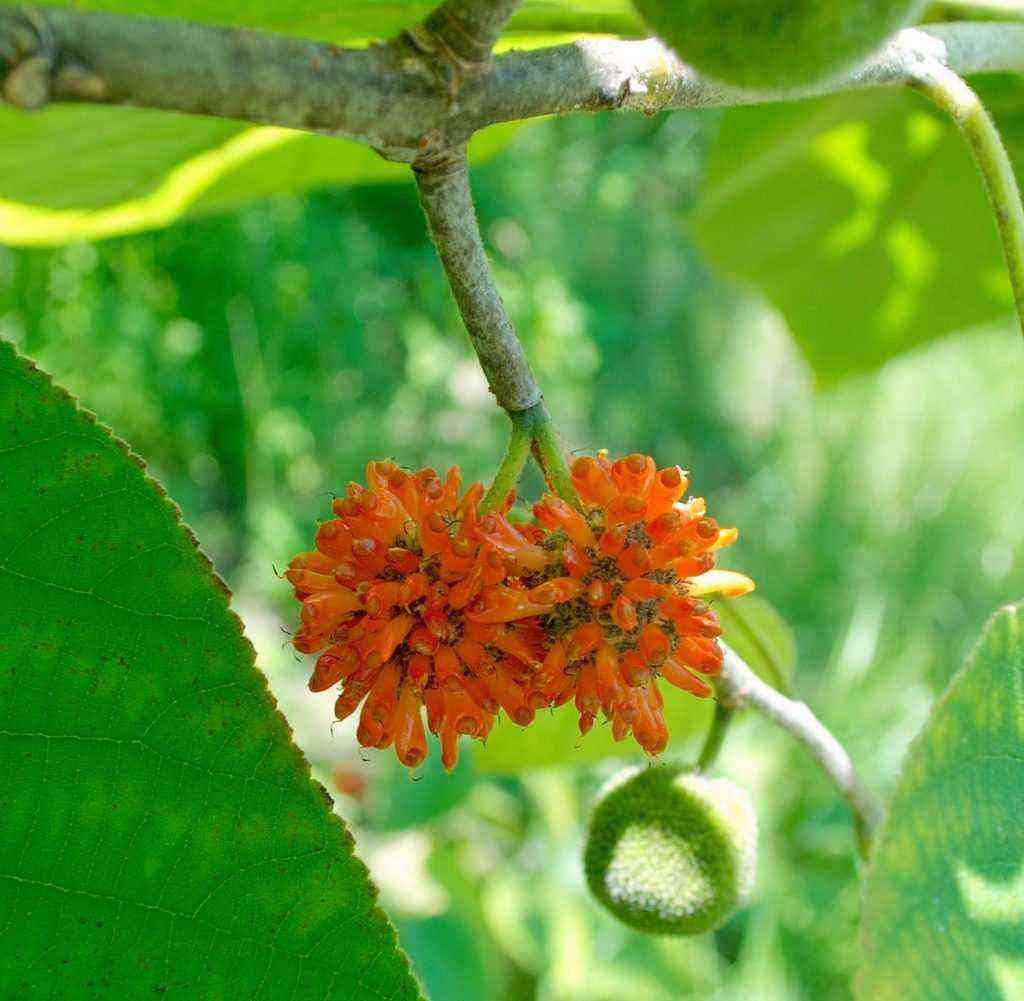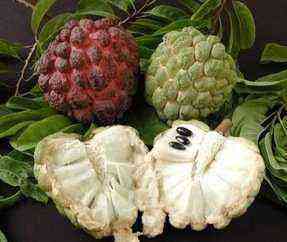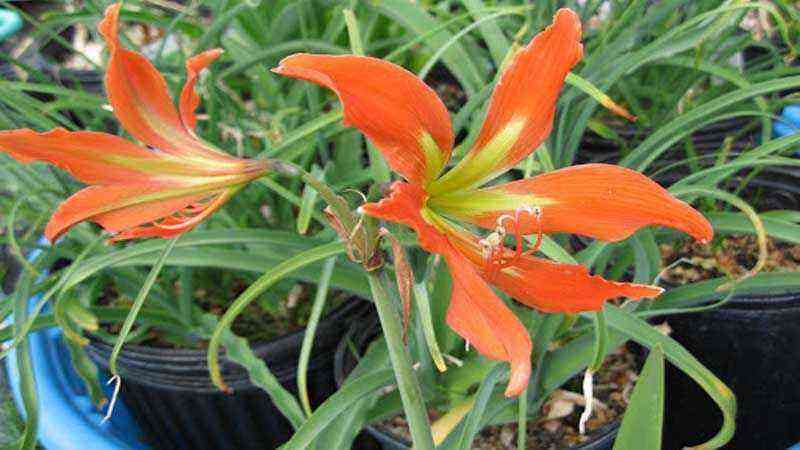How to plant a pine tree with a closed root system. How to plant small-flowered pine “Negishi”
For seedlings with a closed root system, purchased in containers or simply with an earthen clod, there is no strict time frame for planting. They can be planted all year round.
When planting a coniferous plant from a container, carefully remove it from the container. If you have heavy black earth or loamy soils, it is better to cultivate it first with the addition of sand and peat (or pine shavings, fine bark or litter). The soil must be made “light” and air- and water-permeable. If the site does not have at least a minimum slope, a drainage system for coniferous planting sites should be made. There is no need to dig large holes in heavy soils and lay drainage on the bottom – they will serve as water accumulators from the site. It is better to arrange a small slope of the site so that the water does not linger on rainy days. If you have sandy loam soils, you’re in luck. You shouldn’t do anything else. In the prepared ground, a hole is dug to fit the size of the pot (coma) and after the earthen clod of a coniferous plant is established in the planting hole, the air gaps are covered with soil for backfill, trying to fill all the voids. It is very important not to deepen the root collar of the plant, it must be slightly higher than the ground level, otherwise the plant may die. After planting, water the plant abundantly.
Landing
Negishi can be planted from mid-spring to mid-September. Experienced gardeners recommend planting seedlings that are already 3-4 years old.
Important! Before planting small-flowered pine, you should carefully select the planting material. The branches of the seedling should be strong, the needles are bright
—
green, not faded, and the root system without areas affected by rot.
The actual planting of this plant can be broken down into several simple steps:
- Site selection and preparation. The tree loves lighted areas, protected from drafts and strong winds. A hole should be dug 0,5-0,6 m, its diameter should be about 0,7 m. At the bottom, it is advisable to put soil with a layer of 10-15 cm. If the gardener is planting more than one Negishi seedling, the distance between the plants should be about 1, but better than 1,5 m.
- Preparation of an organic mixture. It is necessary to mix sand and turf soil in a ratio of 1: 2. If the soil in which Pinus Negishi is planted is poor in nutrients, a compound fertilizer should be poured into the bottom of the depression. An organic mixture is placed on top of the top dressing, which should fill about 60% of the pit.
- Planting a seedling. The plant must be very carefully placed in the middle of the groove, without touching or damaging the root system. Then pour the soil mixture on top and compact it slightly. It is necessary to ensure that the root collar is not covered.
- Watering and mulching. Immediately after planting, the tree must be watered using about 5–6 liters of water. Then sprinkle the circle around the plant with peat or wood chips.
Reproduction
Pines are grown from seeds (species), and decorative forms are grafted. These plants do not reproduce by cuttings.
Pine from a nut. It is better to sow seeds in spring with preliminary stratification. Its duration for two-leaved species is one month, five-conifers (cedar) 4-5 months. Sowing, planting and growing seedlings are similar to the recommendations for spruce (see articles on this). But there are also some peculiarities.
For better rooting in the year of sowing in the second half of summer, it is advisable to feed the seedlings with a weak solution of nitrate or boric acid. Seeds in most pine species ripen in winter, at which time they need to be harvested. But there is one subtlety here. They ripen in the second and even in the third year after pollination. Cones with such nuts open up, and a thickening in the form of a rhombus or a polygonal pyramid forms at the top of the scales.
Cultivation and care
During the first two years after planting, 30-40 g / m2 of high-grade mineral fertilizer is applied to the trunk circle. In the future, the pines do not need additional feeding. Falling needles, which do not need to be removed, will create a thick bedding in which organic food will accumulate. Its pine tree is sufficient for normal development.
Pine trees are drought-resistant plants, so they do not need to be watered. In addition, coniferous litter retains moisture well. An exception is the Balkan pine (Rumelian), which is hygrophilous, like a spruce, and needs watering 2-3 times per season (15-20 liters per tree).
Pine trees do not need to be trimmed, but the growth of trees can be slowed down, and the crown can be made thicker if you break off a young (light) growth by a third of the length with your fingers.
Description

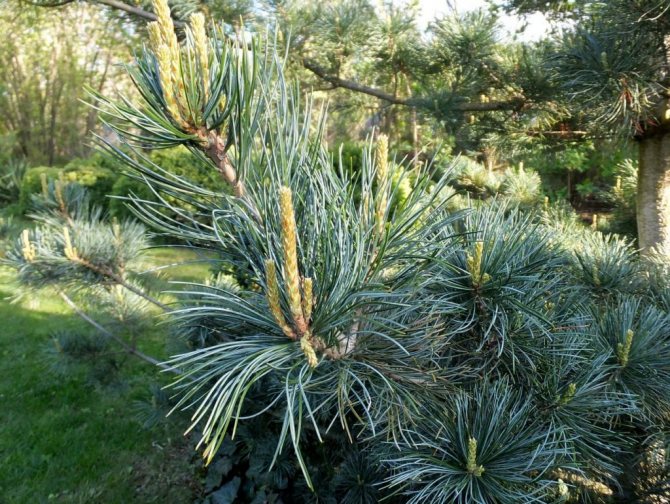
The Japanese white pine (Pinus parviflora) is a breeder’s favorite tree.
Origin and distribution
Pinus parviflora originally grew in the Land of the Rising Sun (Japan) and the Kuril Islands. Then, thanks to the hard work of breeders who developed varieties resistant to the harsh conditions of Russia, the pine spread to the Black Sea coast.
Characteristics and morphology
Japanese white pine comes in several types: with one or more trunks. The tree grows up to 20-25 m in height. Usually has a smooth bark that becomes scaly over time. The needles have a rather unusual appearance: they are soft, curved, slightly curved at the ends, dark green in color. What is noteworthy, the needles have a slight “silvery” bottom, are located in 5 in bundles 3-5 cm long. The crown is loose, openwork, pyramidal. Usually pinus parviflora blooms in May, then oval (short-cylindrical) cones appear up to 5 cm long, which ripen after a couple of years.
Pinus parviflora is quite resistant to urban ecology, capable of withstanding frosts down to -30. Life expectancy is up to 200 years.
Recommendations for growing
Growing conditions
Japanese white pine tolerates light frosts well (up to 30 degrees). The tree is neutral to sunlight, it will be comfortable both under the scorching sun and in the shade. It is also unpretentious to soil conditions, it can grow in any soil. The most preferred soils are wet and drained.
White pine is tolerant to salty soils.
Watering
Moderate watering is recommended; if waterlogged, the plant may die. It tolerates heat better – you can do without spraying on a dry day.
Additional fertilizing
It practically does not need additional nutrition, fertilizers are needed only before flowering or transplanting.
Crown formation, pruning and care
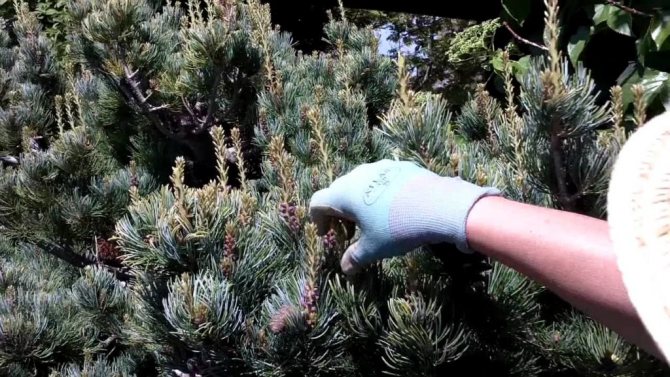
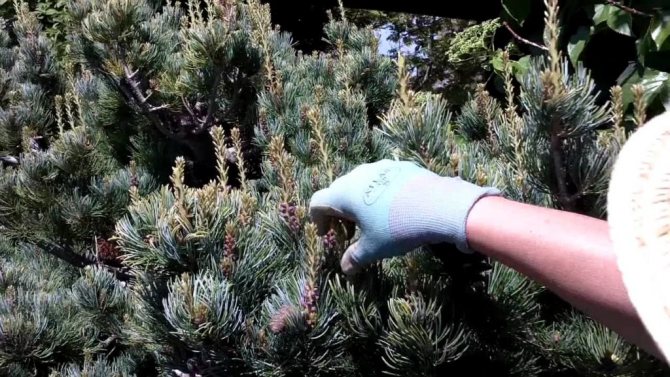
Japanese white pine needs annual spring sanitary pruning. It consists of pinching the buds to keep the tree from growing in an unwanted direction. There are no special recommendations here, the main thing is not to overdo it and not remove the kidneys necessary for growth.
Landing
Germinating a pine tree from seed is not an easy task, so the best solution is to buy a ready-made seedling in the store. This will ensure a quick and easy landing.
Transfer
It is best to transplant before the first shoots, special attention should be paid to the taproot, it should never be pruned! After transplanting, it is advisable to feed the tree, monitor watering.
vermin
In order to detect pests in time, you should pay attention to needles and branches. Here you can find caterpillar cocoons, beetle larvae, aphids, wood lice. Apply chemicals as needed to prevent insect breeding and spread. The most common diseases are rust and root rot. Despite its unpretentiousness, the plant needs a thorough examination for parasites.
Create a conifer garden design: pine. Part 1.
Create a conifer garden design: pine. Part 1.
When creating the design of your garden, you always want it to be for a long time and at minimal cost. In my opinion, pine is a suitable material for creating great compositions. Below I have selected the most interesting varieties that you can use.
First, let’s start with a general description of a plant like pine.
Pine belongs to the pine family and is an evergreen coniferous plant, the appearance of which varies from dwarf shrubs to forest trees up to 75 m high; in most species, the height is 15-50 m and the trunk diameter is up to 2 m. Pine trees reach such dimensions, depending on the type and conditions at the age of 70-100 years, in young trees the crown is conical and in mature trees it is flattened although it can remain quite dense and compact, there are also many dwarf or slow-growing forms that look good in rock gardens or extensive landscape compositions … Some pines are used as decorative, others, especially Scots pine, as windproof. Most pines prefer acidic soils and dry places, some well tolerate thin, infertile or waterlogged soil. All of them are common in the temperate and subtropical zones of the northern hemisphere to Central America and Indonesia, only the Merkuza pine comes south of the equator.The assortment of species and varieties is rich and can satisfy any gardener, for example, Bunge pine, European cedar, Cultera, Dense-flowered, Bosnian, white-brown , Montezum, mountain, small-flowered, drooping or Mexican, weeping, pine, Italian pine, Weymouth dwarf pine, white eastern, ordinary, forest.
Plant pine trees in a permanent well-lit place in the second half of autumn, the soil is preferably acidic and well-drained; do not use lawn mowers and trimmers at the base of the trunks – they can damage the roots of the pine trees located at the very surface.
Reproduction – sow seeds in early spring under glass or later in open ground, replant seedlings to a permanent place, at least after 2 years. As for varietal plants, plant in the fall with cuttings half a pencil in diameter, the optimal rootstock thickness is twice that.
Regarding pruning, then it is rarely required – we remove the frail lower branches. In most pines, pruning them deforms the natural conical shape of the crown.
About pine diseases, you can write a lot, they are amazed by real mushrooms, late blight and rust. Among insects, Hermes, sawflies, and pine silkworm caterpillars are dangerous (the latter species have brown larvae about 2 cm long, which seriously harm pine plantings by eating their young apical shoots). Advice – fight insects with insecticides.
Now let’s look at interesting pine varieties, from the point of view of design and decorativeness, but I want to say right away – this is my point of view, in fact, there are a lot of varieties:
Japanese pine Compacta – Pinus parviflora Compacta
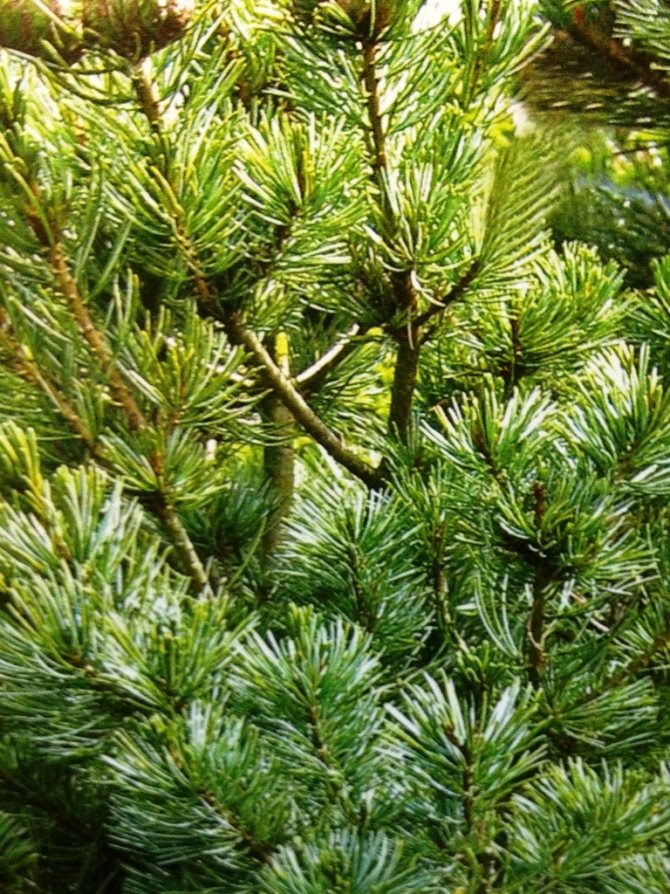
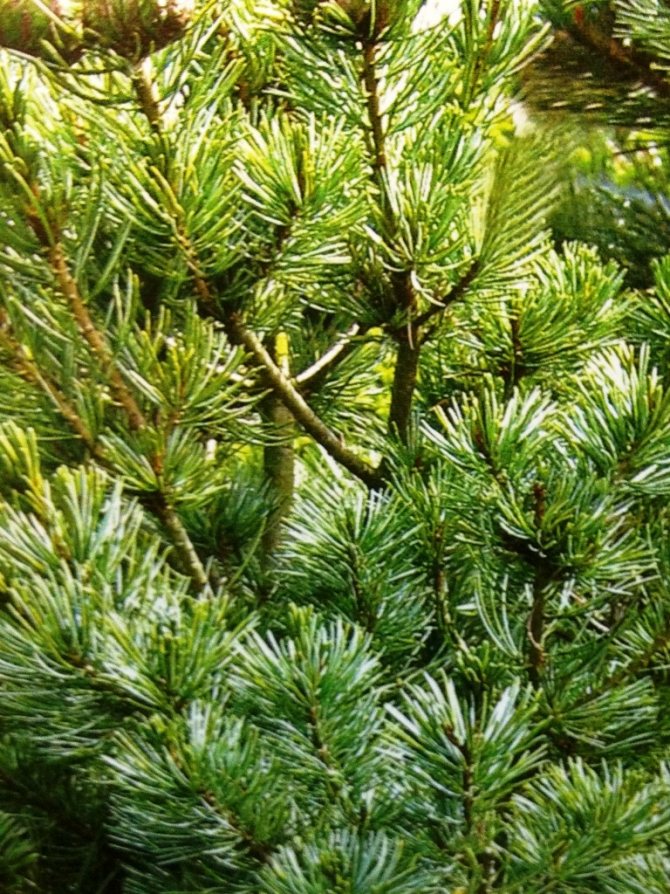
Originally from North Korea, needles, crown and fruits are of interest, growing zone 3 is suitable (see at the end of the article). Compacta is a short tree or, more often, a shrub. An adult plant grows up to 3 m. The crown diameter is the same or slightly less. It grows more slowly than the original form, adding about 10-12 cm annually.Skeletal shoots are long, thick, slightly curved, branching strongly, especially at the ends far from each other, grow evenly, diverge from the center at an angle, directed to the sides and up … The crown is symmetrical, moderately dense, oval or broadly pyramidal, with an indistinct apex. The needles on old shoots are about 5-6 cm long, slightly curved, colored bluish-green, and on young ones they are very short, bright green, tightly pressed. Young growth stands out in contrast against the background of old needles. Numerous cones, collected in large groups, serve as an additional decoration for the plant. Features of cultivation: Pine grows slowly, It can grow both in the sun and in a shaded place. Undemanding to soils, grows on any moderately nutritious and moist garden soils. Moderate winter hardiness. This Compacta variety can become a solitaire (single planting) on the lawn, decorate a rocky, heather or Japanese garden, retaining wall, slope and forest edge. Regarding pruning and disease as well as reproduction – see general description above.
Japanese pine Tempelhot – Pinus parviflora Tempelhot

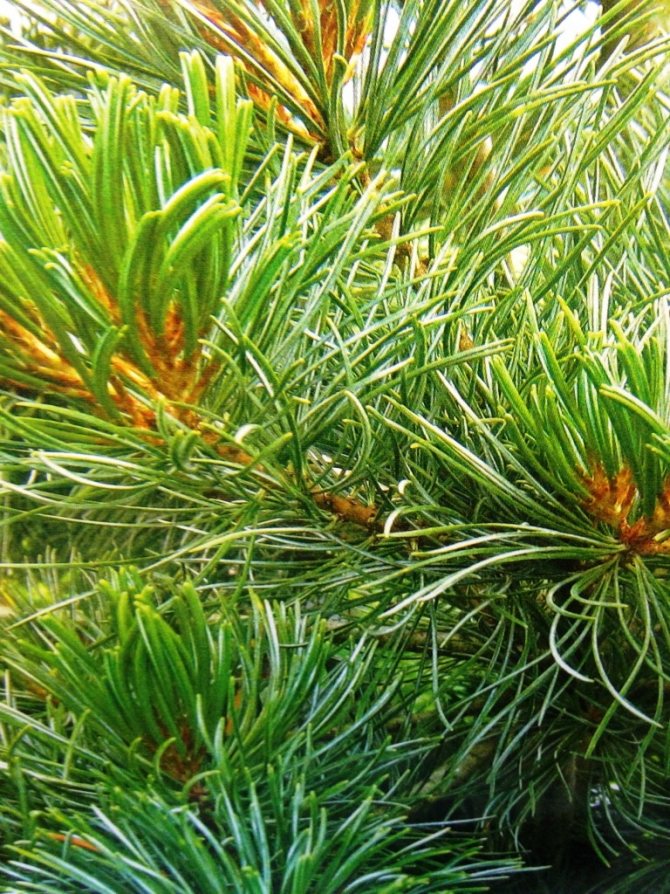
Native to North Korea, Tempelhot is a short tree. An adult plant grows up to 2,5-3 m, with a crown diameter of no more than 1,2-1,5 m. It grows relatively quickly, adding 8-10 cm annually. The trunk is slightly curved, thick. Skeletal shoots are also thick, straight, whorled on the trunk, branching moderately and only at the ends, far apart from each other, growing unevenly, extending from the center at an almost right angle horizontally, and only the upper shoots are directed to the sides and up. The crown is slightly asymmetrical, conical or broadly conical. The needles are long, thin, very dense, straight or slightly crescent-curved, painted in an elegant silvery green color. Young growth differs slightly from old needles. The plant is photophilous, but it can grow in a small shade, while decorativeness does not suffer. Soils are desirable nutritious, moderately moist, drained. Zone 4 is suitable for cultivation. Good winter hardiness. This elegant tree with a beautiful crown can be planted at the edge of the forest, in a rocky, heather or Japanese garden, alone on a lawn, included in a mixed group that forms a free-growing living wall.
Japanese pine – Pinus parviflora

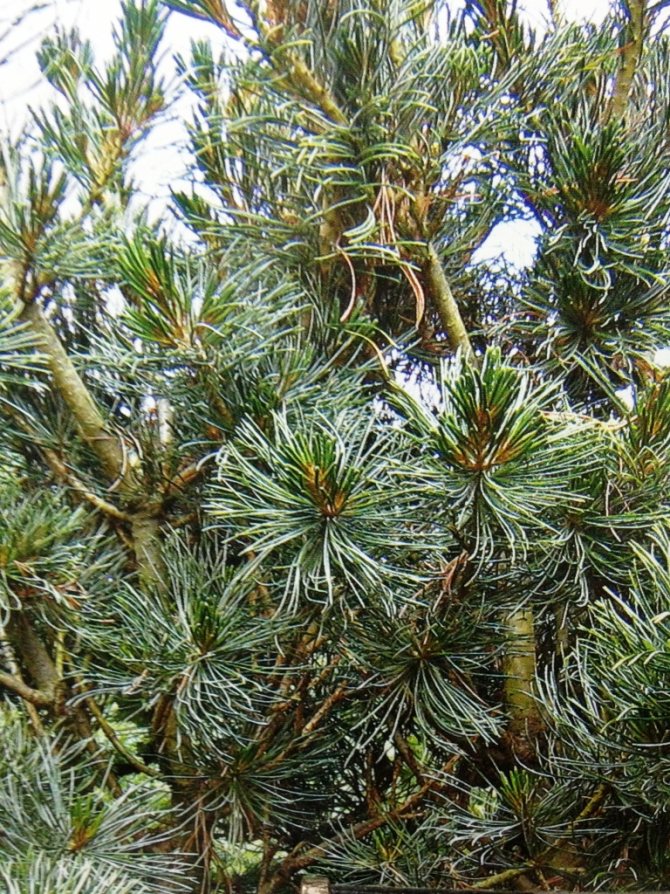
Japanese pine, of course, grows in Japan, and it can also be seen in North Korea. In nature, this is a relatively short tree, no higher than 10-12 m with a crown diameter of about 9-11 m. It grows quickly, on average, the annual growth is 20-25 cm. Young trees have a dense, pyramidal crown, with age, skeletal branches begin to grow larger spread out to the sides, and the crown becomes wide-pyramidal, and then umbrella-shaped or almost flat. The needles are relatively short (no more than 4-6 cm), strongly bent, twisted and form peculiar tassels at the ends of the shoots. On young shoots, the needles are pure blue or bluish-white, and on last year’s gray-green, needles are collected in bunches of 5 pieces. Begins to bear fruit at the age of 8-10 years. Cones can be either single or collected in bunches, beautiful ovoid, up to 10 cm long and 4 cm wide, persist on a pine for 6-7 years. Japanese pine is unpretentious, ready to grow on a variety of soil types, undemanding to either the nutrient composition or the acidity of the soil, it can grow both in the open sun, without suffering from sunburn, and in moderate shade. The level of illumination does not affect the decorativeness of the plant. Japanese pine and its decorative forms grow well in containers. She could rightfully become a universal coniferous plant in the garden, if not for the very low winter hardiness. Zone 5A, since the natural species can only be used in landscaping gardens located in areas that are not subject to excessively low winter temperatures (not lower than -25-28 ° C). Numerous garden forms of Japanese pine are distinguished by their modest size, they winter well even at low temperatures, covered with snow.
Black Pine Jeddeloh – Pinus nigra Jeddeloh


This pine comes from Italy, but it can grow in zone 4, since the frost resistance is good. Jeddeloh is a short tree. An adult plant grows to 2,8-3 m with a crown diameter of about 1 m. It grows relatively quickly, the annual growth is 12-15 cm. The trunk is straight, even. Skeletal shoots are very short, strongly branch at the ends, far apart from each other, grow pronounced unevenly, depart from the center at an almost right angle and are directed to the sides. The ends of the shoots rise up. The crown is formed asymmetric, openwork, sparse, conical or pyramidal. The needles on old branches are very long, thin, sharp, tough, often twisted, arranged radially, colored dark green, and on young ones they are short, bright green, pressed tightly. The plant is selected a place illuminated throughout the day. Undemanding to soils, can grow on any moderately nutritious and moist, drained garden soils. For a tree with such an unusual, spectacular crown, it is desirable to provide an all-round view. It can be planted singly on the lawn, in the front area of the garden, to decorate with it a rocky, heather or oriental garden, the edge of the forest, a retaining wall.
Scots pine Waterreri – Pinus sylvestris Watereri

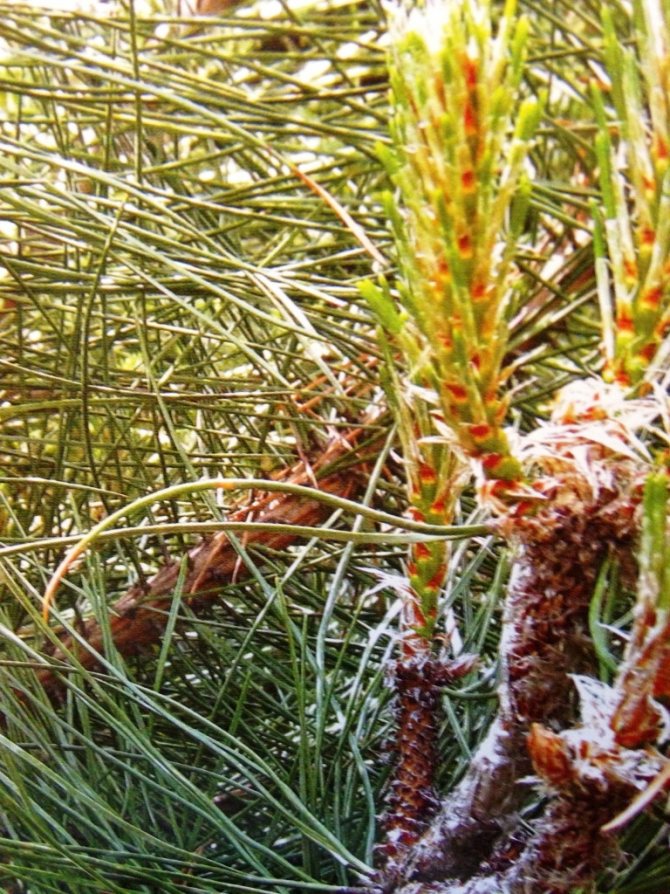
Came to us from the Northern Hemisphere, Watereri is a dwarf, often multi-stemmed tree or shrub popular in landscaping. An adult plant reaches a height of no more than 3-4 m, rarely more. The diameter of the crown is about 3 m. It grows rapidly, annually adding from 20 to 30 cm in height and 10-15 cm in width. Skeletal branches are long, thick, strongly branched at the ends, grow evenly from the center, depart at an almost right angle and directed to the sides. The ends of the shoots are slightly bent upwards. The crown is dense, symmetrical, at first spherical or rounded, then it becomes wide-conical or pyramidal, with an indistinct apex. The needles on old branches are long, moderately dense, thorny, crescent-curved, often twisted, arranged radially, painted in a rich green color with a bluish tinge, and on young ones they are short, tightly pressed, painted in a bright grassy green color. The plant is light-requiring. In shady places it develops poorly, the crown becomes sparse. Moderately nutritious and moist, drained, loose soils are required. Grows well on sandy loam. The plant can be planted in the front part of the garden, alone on the lawn, at the edge of the forest, and included in a free-growing hedge. Winter hardiness is high, in zone 3 it will grow well.
Scots pine Globoza Viridis – Pinus sylvestris Globosa Viridis
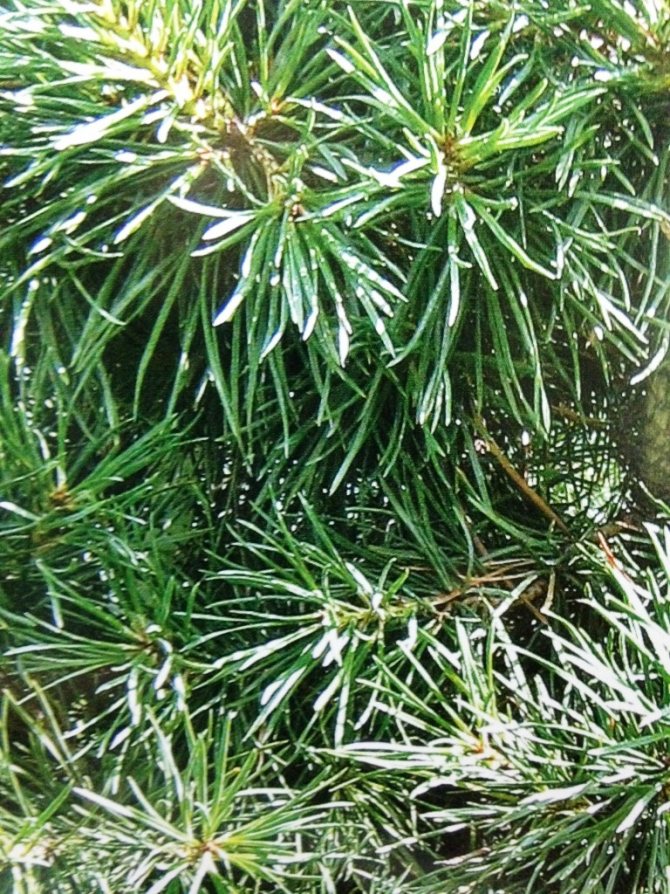
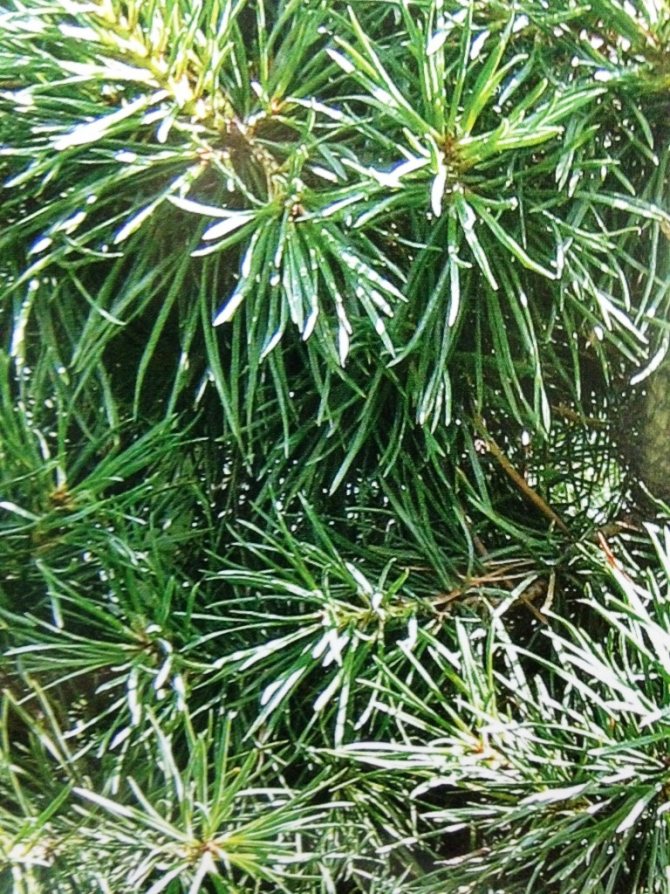
Another representative of the Northern Hemisphere – Globosa Viridis – a dwarf tree or bush-like form, reaching a height of 1,5 m with a crown diameter of 1,2-1,3 m. Skeletal shoots are short, thick, strongly branching, especially at the ends, grow evenly, depart from the center at an almost right angle, directed mainly to the sides and slightly upward. The lower branches lie on the ground, and the trunk is not bare, even in older specimens. The crown is formed symmetrical, very dense, dense, at first flattened-spherical, then becomes ovoid or oval with an indistinct apex. The needles are long, tough, dense, slightly crescent-curved, sometimes twisted, colored dark green. Young growth is one tone lighter. Pine grows slowly. The plant is light-requiring. In shady places, the shoots are unnecessarily stretched to the sides, and the crown becomes loose. Moderately nutritious and moist, drained soils are desirable. Grows well even on poor sandy soils. Absolutely does not tolerate waterlogging of the soil and the compaction of its upper layers. High winter hardiness, grows well in zone 3. This elegant, attractive plant will be appropriate in a rocky, heather and Japanese garden, on a retaining wall, slope, forest edge. May become a tapeworm on the lawn.
Mountain pine mugus – Pinus mugo var. Mughus
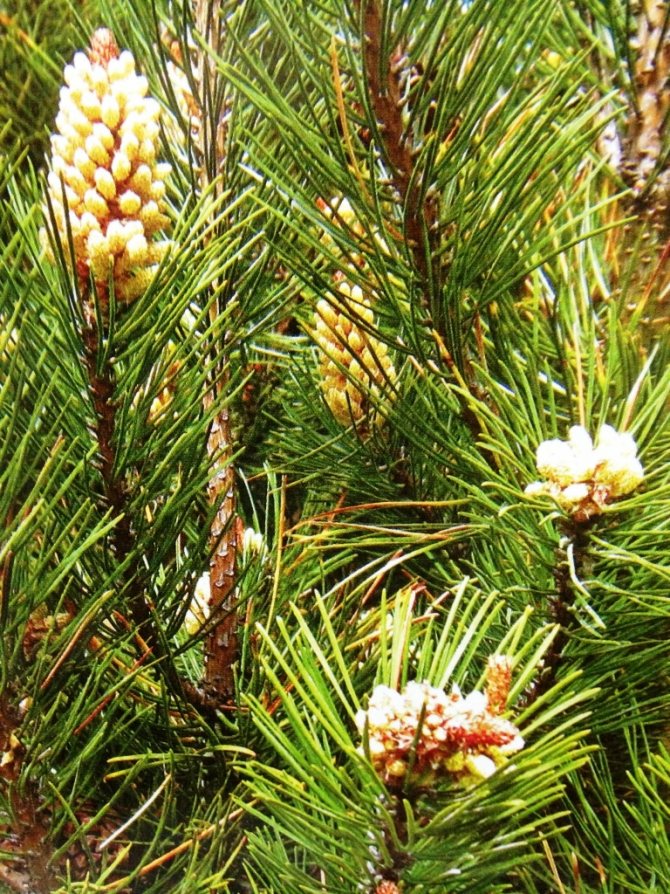

Var. mughus is a widespread shrub in nature. Grows in the mountains – from the Eastern Alps to the Balkans. The height of an adult plant is usually 1,5-2 m, but you can find specimens that have reached the mark of 3 m. The diameter of the crown is about 1,5 times larger. Grows relatively slowly, the annual growth is 6-8 cm. Skeletal shoots are short, thick, numerous, of different lengths, growing unevenly. In young specimens, they depart from the center at an acute angle, are directed slightly to the sides and mainly upward, and the crown is formed almost spherical or oval, asymmetric. Over the years, the shoots begin to move away from the center at a large angle, some spread, and the crown becomes prostrate, sometimes even cushion. The crown at a young age is dense, thick, then it becomes openwork. The needles are long (up to 4-4,5 cm), rigid, thick, crescent-curved, sometimes twisted, painted in dark green. Young growth is slightly lighter. During flowering, the plants are highly adorned with the creamy yellow anthers of numerous male inflorescences. The shrub is light-requiring, although it can grow in a light shade, the crown becomes more spreading. It does not have special requirements for soils, but it grows poorly on acidic soils. High winter hardiness, zone 2. The large size of the shrub suggests its use in large gardens. They can decorate slopes, forest edges, retaining walls, and include them in free-growing hedges.
Wallichiana Pine Denza – Pinus Wallichiana Penza
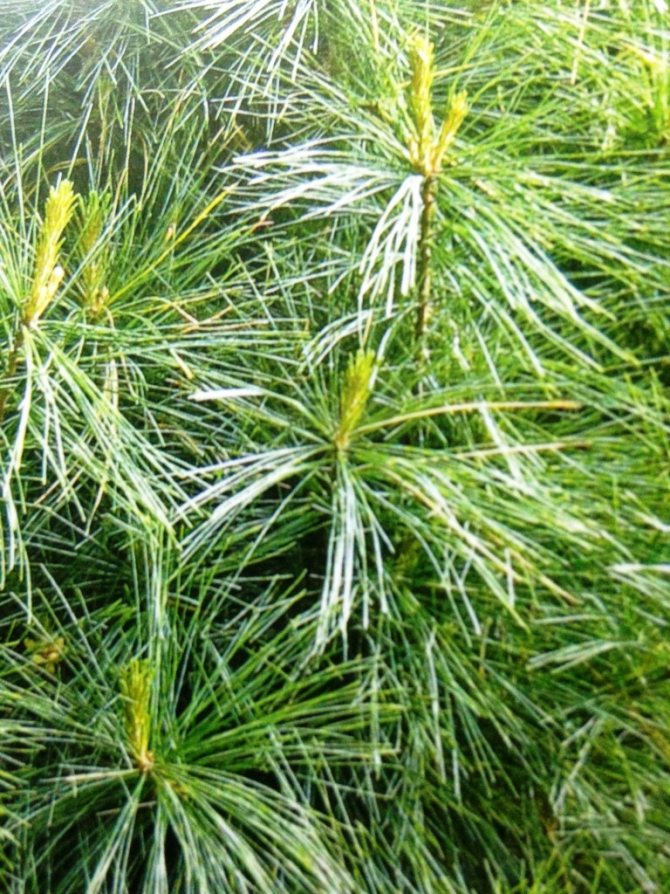
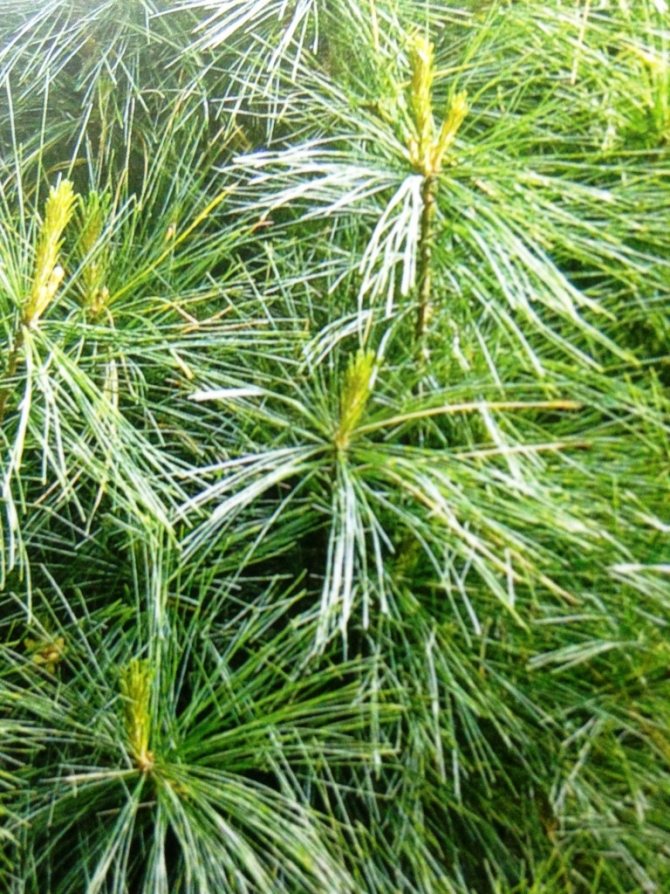
Wallichiana Pine is a fast-growing, large, tall tree native to the Himalayas. In its native mountains, this tree reaches a height of 45-50 m, and in culture it is not higher than 20-25 m. The annual growth is about 25-30 cm. The crown is very beautiful, even, symmetrical, pyramidal, the lower part of the trunk is not bare, branches lie on the ground. The needles are very long (up to 18-20 cm), thin, sharp, hanging on old shoots, collected in 5 pieces, painted in a bluish-silver color. On young shoots, the needles are shorter, stand upright. Cones are light brown, up to 25 cm long. Denza is the most popular and widely used form in landscaping. Often goes on sale under the name Denza Hill (Denza Hill). An adult plant grows up to 4,5-5 m with a crown diameter of 2,5-2,8 m. It grows rapidly, adding at least 20-25 cm annually, in favorable years up to 30 cm. The trunk is straight, even. Skeletal shoots are long, thick, strongly branched, far apart, grow evenly, directed to the sides and up. The crown is formed regular, symmetrical, dense, conical or broadly conical. The needles are slightly shorter than that of the original species, thin, densely located on the shoots, hanging down beautifully, painted bluish-green with a slight silvery tint. Young growth is slightly lighter. It grows quickly, is unpretentious, grows on a variety of garden soils, and is very light-requiring. However, it also has a drawback – insufficient winter hardiness, so this is zone 5a and with a stretch 4. Perfect for decorating slopes, forest edges, walking paths. Can be grown on alpine slides, rocky, heather and Japanese gardens.
European cedar pine Pygmea – Pinus cembra Pygmaea

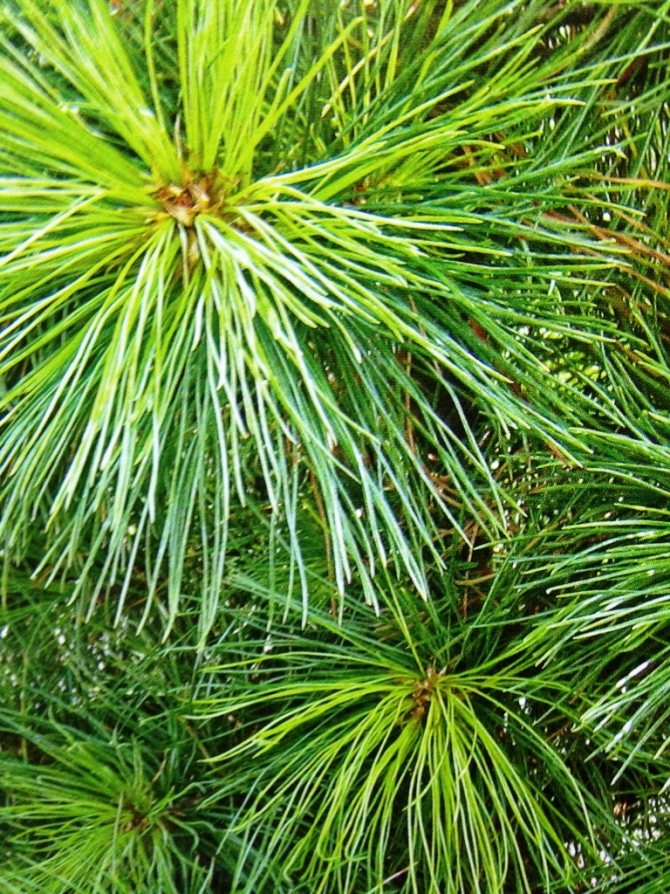
European cedar pine, or European cedar, is ubiquitous in central Europe. In nature, it is a moderately tall tree, rarely exceeding 20-25 m. It grows very slowly, but after 30 years the growth rate increases. The crown is dense, dense, conical or ovoid. When trees stand close, the trunk may be exposed from below. The needles are long (up to 6-8 cm), straight, soft, collected in 5 pieces, painted in a bright green color with a slight bluish tinge, on the inside – blue-white. Young cones are purple, mature ones are reddish-brown, 6-8 cm long. The seeds are edible nuts. The breed is unpretentious, grows on any moderately nutritious, sufficiently moist soils, prefers drained loams. Photophilous, but shade-tolerant, very hardy. For cultivation, zone 3 is suitable. The Pygmaea variety is a dwarf tree no more than 1-1,2 m high with a crown diameter of 50-60 cm. It grows slowly, the annual growth is about 3-5 cm. Skeletal shoots are very short, thin, moderately branched, grow unevenly. In young specimens, the branches are far apart from each other; with age, the crown becomes denser, acquires a wide pyramidal shape. The needles are long, thin, with a pointed tip, sometimes slightly twisted, painted in a spectacular blue-green color. The young growth is bright herbaceous green, contrasting against the background of old needles. The plant is bright. In shady places, the crown remains loose, and the needles do not acquire their elegant tone. Soils are desirable nutritious, moderately moist, drained, ideal loam. Winter hardiness is high, therefore zone 3. The tree will bring brightness to the composition on an alpine hill, in a rocky and heather garden, on a retaining wall and a slope, at the edge of a forest and in the coastal zone of a reservoir. But the Alba variety is a tall tree, not less than 15-18 m. The crown diameter is about 7-10 m. It grows rapidly, with an annual growth rate of 20-25 cm. The barrel may be slightly bent. Skeletal shoots are long, thick, branch mainly at the ends, grow unevenly. In young specimens, the branches branch off from the center at a slight angle, directed to the sides and up. The crown is formed asymmetric, broadly pyramidal, with a vaguely defined apex. Over time, skeletal shoots descend, are arranged horizontally, and the crown becomes wide-spread, umbrella-shaped. The needles are long (7-9 cm), thick, flat, slightly twisted and sickle-curved, of an unusual gray-blue color. Young growth from old needles is practically indistinguishable. The plant is bright. It develops poorly in the shade, moreover, a green tone appears in the color of the needles. Soils are desirable light, well-drained, moderately moist, ideal sandy loam. Winter hardiness is high, therefore zone 3. This beautiful, majestic tree can be planted singly on the lawn, decorate the edge of the forest area with it. Alba’s rather large dimensions suggest its use in large gardens. Choose an open, lit place for the plant. The slightest shading leads to a thinning of the crown, while the trunk is gradually bare from below. Undemanding to soils, grows well on any garden soils.
Pine Banks Compact – Pinus Banksiana Compacta
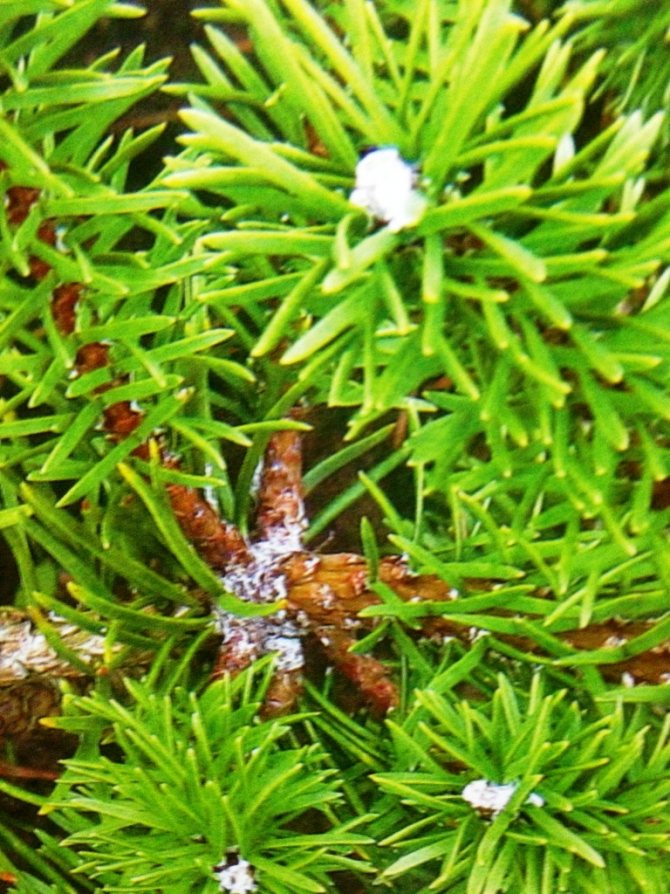
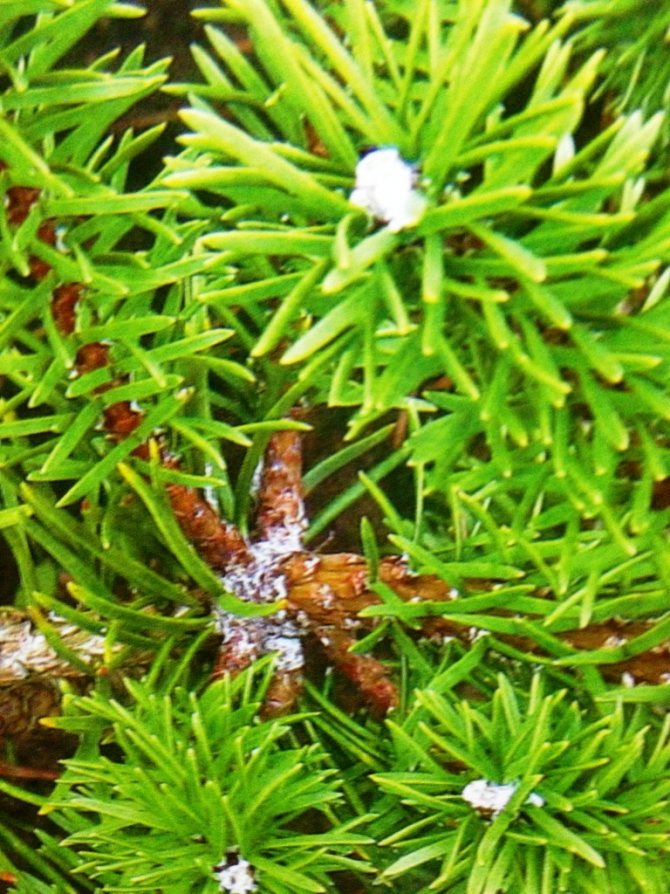
Pine Banks is a resident of the eastern regions of Canada. The further north the plant moves, the squat its crown becomes. If usually the height of an adult pine reaches 15-20 m (sometimes 25 m), closer to the north it takes the form of a bush. It grows slowly. The tree is often multi-stemmed, with a compact, sparse, asymmetrical, oval crown. The needles are tender, strongly curved, twisted, collected in 2 needles. Cones are conical in shape, slightly curved, on the shoots, as a rule, are arranged in pairs. The plant is light-requiring, undemanding to soil. Resistant to pathogens and frost-resistant. Compacta is a dwarf bush-like form of the Banks pine. An adult plant reaches a height of about 1,5 m with a crown diameter of 2-2,5 m. It grows relatively quickly, adding 12-15 cm annually. Skeletal shoots are long, thick, serpentinely curving, grow unevenly from the center, are located mainly horizontally some branches lie on the ground. The crown is asymmetrical, wide, flattened-rounded, and with age it becomes more and more flat. The needles are short, flat, radially extending from the shoot, slightly crescent, densely covered branches, painted in a rich green color. Young growth is one tone lighter. The plant is light-loving, but can grow in light shade. Soils are required moderately moist and nutritious, drained, with a neutral or slightly acidic reaction. Perfect for decorating slopes, forest edges, walking paths. Can be grown on alpine slides, rocky, heather and Japanese gardens. High winter hardiness, zone 2.
Japanese pine Glauca – Pinus parviflora Glauca
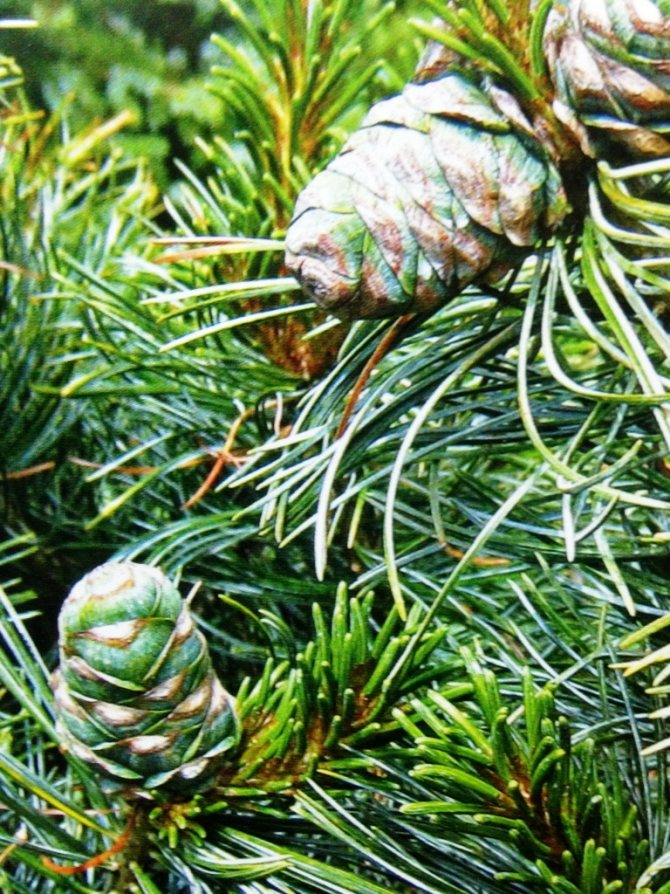
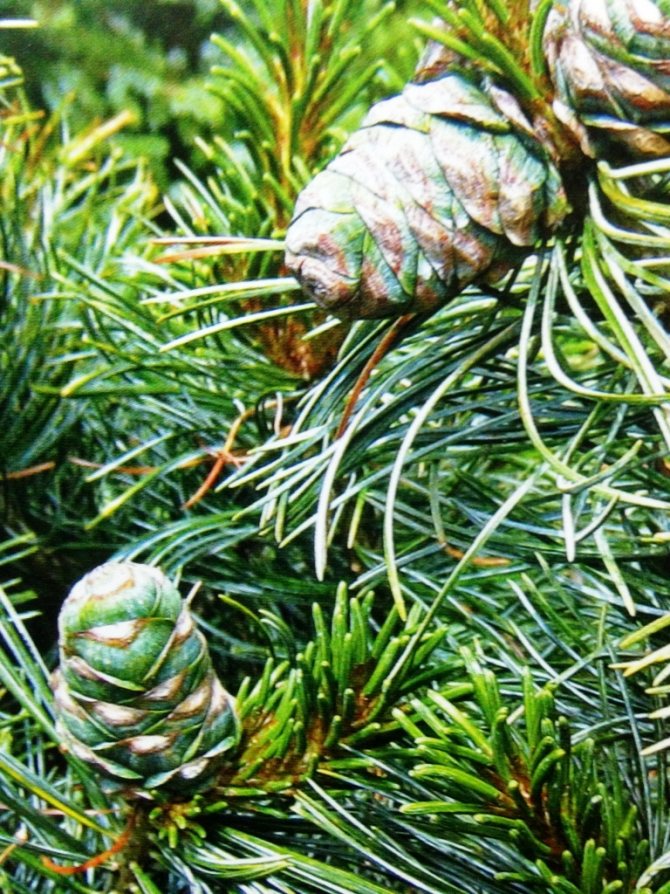
A small tree from North Korea came to us – Glauca. Height does not exceed 1,8-2,5 m with a crown diameter of about 1,5 m. It grows slowly, the annual growth is 10-12 cm. Skeletal shoots are thick, often slightly curved, strongly branching (mainly at the ends), far from each other from a friend, grow expressed unevenly. The crown is formed asymmetric, openwork. In young specimens, the skeletal branches branch off at an angle, directed to the sides and up, the crown is pyramidal or wide-pyramidal. With age, the branches lie horizontally, and the crown becomes broadly spreading, umbrella-shaped. The needles on old shoots 5-7 cm long, tough, sickle-curved, bluish-green with a silvery tinge, and on young ones it is much shorter, painted in bright green, loosely adherent. Cones are numerous, very long (up to 10 cm), young bluish-green, mature brown. Glauca is shade-tolerant, but grows better in open places. Grows well on garden soils of any type, with the exception of heavy and excessively moist. An elegant plant for decorating alpine hills, rocky, heather and Japanese gardens, retaining walls, slopes, forest edges. May be a tapeworm on the lawn. Moderate winter hardiness, zone 5a.
Black Pine Pygmea – Pinus nigra Pygmaea


Pygmaea is a natural dwarf form found high in the mountains of Italy. It reaches a height of no more than 1,8 m. The crown diameter is the same or slightly larger. It grows very slowly, the annual growth does not exceed 4-6 cm. Skeletal shoots are short, thick, weakly branching, but numerous, grow unevenly, tightly pressed against each other, depart from the center at an angle, directed slightly to the sides and up. The crown is formed dense, dense, asymmetrical. In young specimens, it is broadly pyramidal, with a clearly pronounced apex, but over time it flattens, to a greater extent spreads to the sides and becomes broadly oval. The needles on old branches are very long, thin, sickle-curved and twisted, radiate radially, painted in a rich green color, and on young ones they are short, very sparse, slightly lighter colored, tightly pressed. The plant is sun-loving, the most open places, illuminated by the sun throughout the day, are selected for it. It is undemanding to soils, it can grow even on poor, moderately moist garden soils. Good winter hardiness, zone 4. Looks great alone on the lawn and in rocky, heather and Japanese gardens, on retaining walls, slopes, forest edges.
Scots Pine Suecia – Pinus sylvestris Sueccia
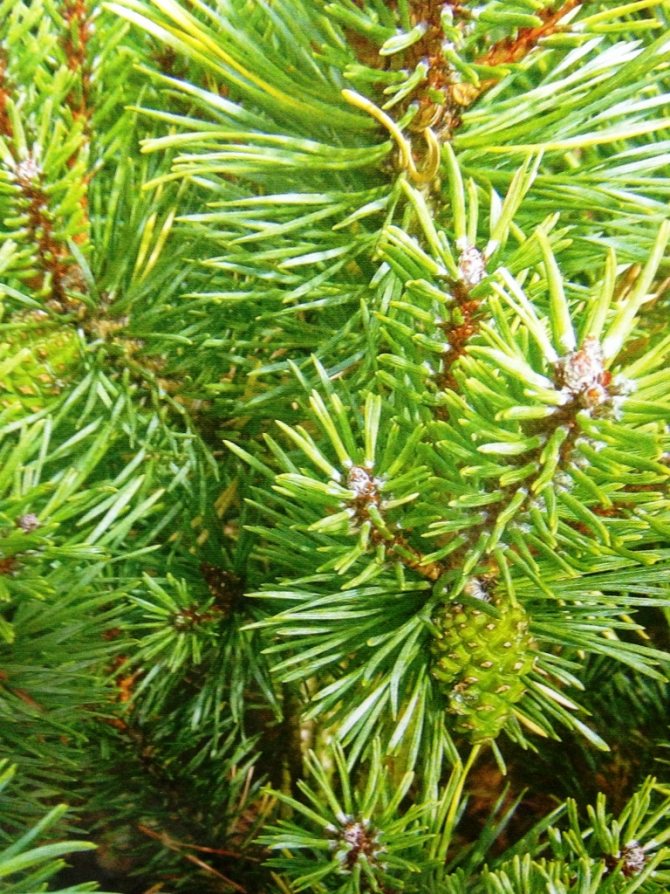
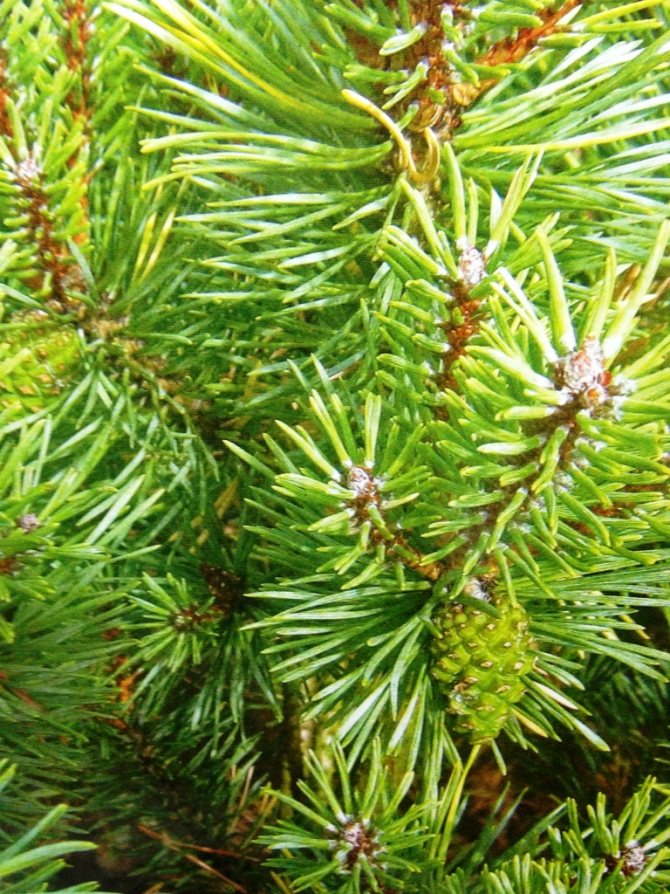
From the Northern Hemisphere came to us – Sueccia bonsai, reaching a height of 3-4 m with a crown diameter of no more than 1,5 m. It grows relatively quickly, the annual growth is 15-17 cm. The trunk is sometimes slightly curved. Skeletal shoots are short, thick, far from each other, are whorled on the trunk, grow unevenly over the years, but towards the final formation the crowns are leveled, branch very moderately, depart from the center at a slight angle, directed to the sides and up. The crown is symmetrical, openwork, conical or broadly conical. The needles are of medium length, thick, dense, dense, sickle-curved, often twisted, painted in a bright green color. Young growth is slightly lighter. Good frost resistance, zone 3. The plant is photophilous, but it grows in a very light, delicate shade, while decorativeness does not suffer. Soils are desirable nutritious, moderately moist, drained. This tree can become a tapeworm on the lawn, used in the design of a rocky, heather or Japanese garden, retaining wall, forest edge, become part of a free-growing hedge.
Balkan Pine Select – Pinus Flight Select
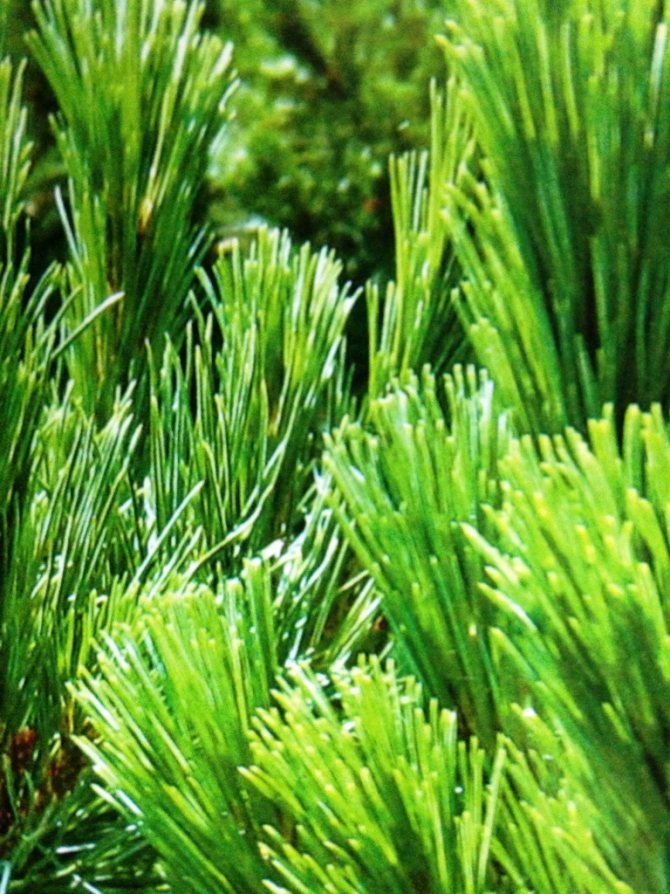

It is not hard to guess that the Balkan pine, or Rumelian, comes from the Balkan Peninsula. In nature, it reaches a height of 18-20 m with a crown diameter of 4-5 m. The crown of the tree is beautiful, dense, dense, narrow-pyramidal, with a clear silhouette. The barrel is not exposed from below. The needles are sticking out, dense, straight, dark green or green with a bluish tinge, up to 7-10 cm long. Cones are numerous, erect, elongated (up to 12-15 cm), light brown. The seeds ripen in the fall and quickly fall to the ground. Resistant to rust and the scourge of conifers. The root system is deep. In culture, this species has been used for about 150 years, but few garden forms are known. Select is a low, beautiful tree. An adult plant grows up to 5-6 m with a crown diameter of about 2-2,5 m. It grows relatively quickly, adding up to 20-23 cm annually. The trunk is even, straight. Skeletal shoots are straight, short, grow evenly, depart from the trunk at an acute angle and are directed mainly upward. In young specimens, shoots branch moderately, then branching intensifies. The crown is formed regular, symmetrical, narrow, conical, with a beautiful, well-defined silhouette. The needles are long, straight, tightly pressed on young shoots, radially located on overwintered branches, dense green. Young growth is one tone lighter. The plant is light-requiring. In shaded areas, the shoots are unnecessarily stretched to the sides, and the crown loses its beautiful silhouette. Soils require moderately nutritious, slightly moistened, ideal loam or sandy loam, moderately seasoned with organic fertilizer. High winter hardiness – zone 4. This tree is in demand for landscaping small gardens, looks great in rocky and Japanese gardens, on retaining walls and edges, as part of free-growing hedges.
In any case, if you are a big fan of pine, then you need to take into account not only its decorativeness, and sometimes suppress the desire “I WANT”, but if you cannot suppress it at all, then first learn about the plant more, how it grows, where is better growing, its size, agricultural technology, and everything else. Since a large pine tree in a small garden will not be relevant, but its dwarf forms are just right.
As promised, here is the information on the growing zones:
Zone 1 – Central Siberia
Zone 2 – Southern Siberia
Zone 3 – Lapland.
Zone 4 – Moscow region, most of Russia, northern and mountainous regions.
Zone 5a – St. Petersburg, Vladivostok, Minsk, Kiev, central Russia, the Baltic countries.
Zone 5b – Northeastern Poland, western Ukraine, southern Sweden, southern Finland,
Zone 6a – Eastern Poland, Slovakia, central Sweden, Southern Norway
Zone 6b – Central Poland, eastern Hungary, Czech Republic.
Zone 7a – East Germany, western Poland.
Zone 7b – East Holland, Denmark.
Zone 8a – Central Holland, Belgium, northern and central France, northern England
Zone 8b – Maritime Holland, Western France, northern Italy, central England.
Zone 9 – Southern France, central Italy, Portugal, southern England.
Zone 10 – Southern Italy, southern Spain, central Greece.
Zone 11 – North Africa.
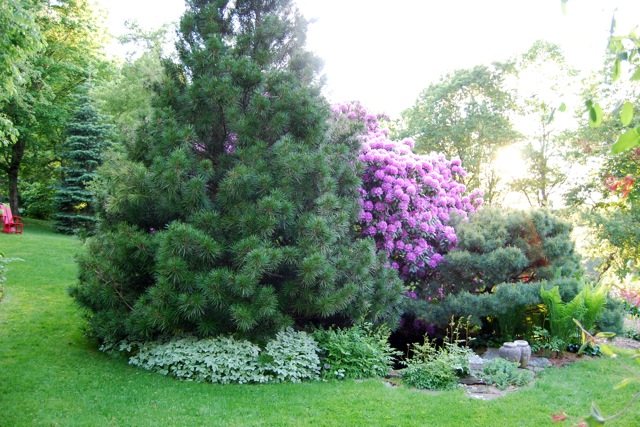
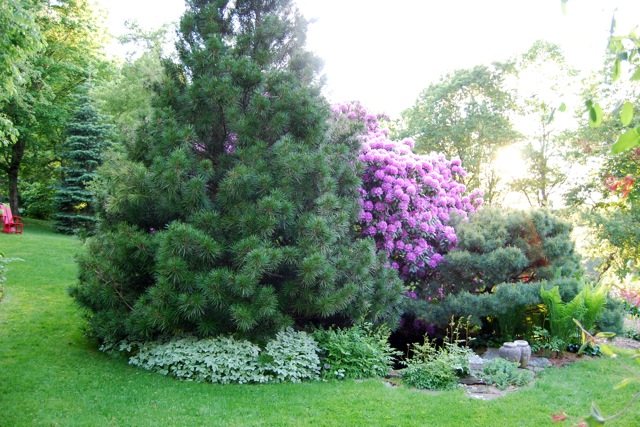
I wish you inspiration when creating compositions from conifers such as pine. Good luck to you.
Decoration of a decorative landscape with a small-flowered pine tree
Among coniferous varieties of trees, small-flowered pine has taken a special place. It is characterized by a conical crown, dark silvery curved needles and smooth bark. Throughout the year, the tree does not lose its colors, which allows it to serve as a color accent in landscape composition. Pine trees are in demand in the decorative landscape, attracting with their evergreen color and healing properties.

